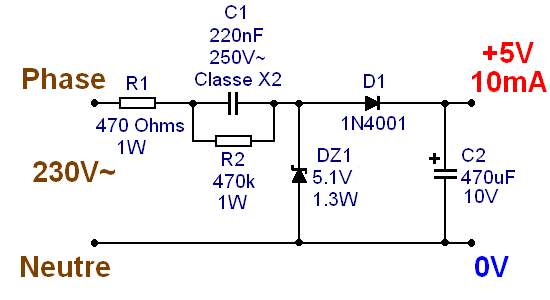I need to take 20ma from output of 7805.My input voltage is Ac variable voltage (0-300Vrms).I am planning use to pre regulator for 7805 and full bridge rectifier.Maybe I can reduce input voltage of 7805 to 30V from (0-300 Vrms).I can use mosfet for pre regulating. Do you have a sample circuit on this subject for my inspiration?In summary, I should be able to take 20ma from output of 7805,in (7-300Vrms).(7=5+7805_dropout_voltage).Actually 7 volts can be 9-10volts.(not important). how can I do it?
-
4\$\begingroup\$ Do you actually need 0-300VAC input? Sounds like probably over speccing to me. \$\endgroup\$– DKNguyenCommented Feb 16, 2021 at 14:31
-
6\$\begingroup\$ Standard solution is voltage transformer, diode rectifier and capacitor. Use some wall cube with output 9-12V \$\endgroup\$– user263983Commented Feb 16, 2021 at 14:36
-
2\$\begingroup\$ ” Maybe I can reduce input voltage of 7805 to 30V from (0-300 Vrms)” “Maybe I can” is strange wording here considering the max input voltage of 7805 is 25 V. “I must” would fit better :-) \$\endgroup\$– winnyCommented Feb 16, 2021 at 14:37
-
2\$\begingroup\$ You need to drop 390V at 20ma (300Vrms is ~420V peak, minus the target voltage of 30V). This will dissipate 7.8W. This is doable, but you need to keep in mind the preregulating mosfet will need a significant heatsink. Moreover, your solution isn't galvanically isolated. Overall, using a small premade AC-DC module or transformer may be simpler, smaller, cheaper and safer. \$\endgroup\$– dimCommented Feb 16, 2021 at 14:40
-
3\$\begingroup\$ WARNING: All parts of a capacitive dropper circuit must be treated as if they are at full mains potential at all times. Component failure or miswiring can result in full mains voltage appearing at the output. This type of circuit should only be used when the output is fully isolated from user contact. \$\endgroup\$– Russell McMahon ♦Commented Feb 17, 2021 at 14:07
1 Answer
Two options for you.
- Use a step down transformer from your 300V RMS to about 12V RMS, then you can use a half wave rectifier or full-wave rectifier depending on what you have available.

Image source: https://learnabout-electronics.org/PSU/psu23.php
- If you don't have a transformer, then you can go for a cap dropper circuit, which is a transform less power supply topology as shown below, you can replace the zener diode with your 7805 fixed regulator, (Safety hazard present).
The amount current available will depend on the value of your cap, calculations is easy, you just need to find your Xc value and do basic ohm law.
Image source: https://www.tpub.com/neets/book2/4c.htm
Small cap in the tune of nano-farads will results in higher Xc and less current flowing in from the mains.
https://cdn3.astuces-pratiques.fr/imagesarticles/24/alimentation-capacitive-sans-transfo.png
___________________________
WARNING: All parts of a capacitive dropper circuit must be treated as if they are at full mains potential at all times. Component failure or miswiring can result in full mains voltage appearing at the output. This type of circuit should only be used when the output is fully isolated from user contact.
-
\$\begingroup\$ KISSANGOU - Hi, Are those 3 images your own creation? As required by this site rule, when we include something in an answer (e.g. photo, image or text) which isn't our own original work, we need to properly reference (cite) it in the answer. For images that came from elsewhere, please edit your answer & add a link back to the original web page for each one. If you created any of them, then please add a note for any image where that is true. Thanks. :-) (As a new member, I also recommend you read the tour and help center to see the rules.) \$\endgroup\$– SamGibson ♦Commented Feb 16, 2021 at 19:17
-
\$\begingroup\$ They are google images on the public domain, are you the site moderator? \$\endgroup\$ Commented Feb 16, 2021 at 19:32
-
\$\begingroup\$ KISSANGOU - Hi, "They are google images on the public domain" As you can see on the rule that I linked, there is no exception for that. A link to the original source page for each image is still needed by the site rules here. The original source can be found on the Google image search page that you used. "are you the site moderator?" No, I'm not, I'm helping you to understand what the site rules are here (as any member could tell you) so that you can comply with them. If you would like me to get a moderator involved, then just let me know and I'll do that. Thanks. \$\endgroup\$– SamGibson ♦Commented Feb 16, 2021 at 19:38
-
1\$\begingroup\$ @KISSANGOU I am a site moderator. (The small diamond after my name indicates this). The rules of the site were provided for you to read when you joined. It is good that you are using public domain images, but we need to be "squeaky clean" and a traceable chain to a source indicating licence status helps AND may allow people who are interested technically to back trace to related information. | I could not find matching images using Google image search. It is a simple matter when you source an image to add a "From here" link. | Please add source links for your images. \$\endgroup\$– Russell McMahon ♦Commented Feb 17, 2021 at 14:01
-
1\$\begingroup\$ @KISSANGOU I suspected as much. That means a rare downvote from me for random google examples that don't actually answer the question. It's far from clear that the user is familiar with the capacitors needed \$\endgroup\$– Chris HCommented Feb 18, 2021 at 7:22


